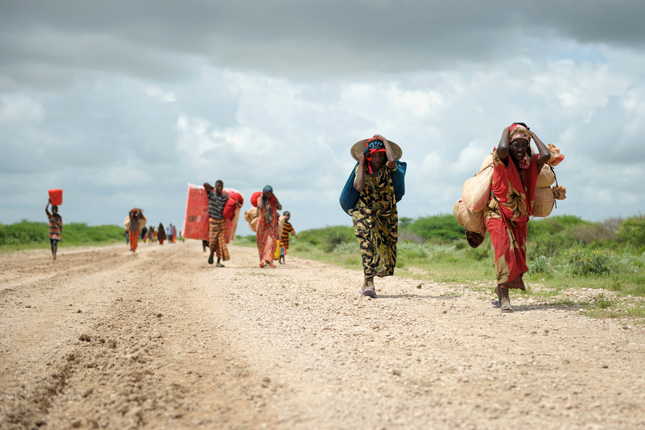-
Navigating Complexity: Climate, Migration, and Conflict in a Changing World
November 28, 2016 By Schuyler Null
Record levels of displacement and accelerating climate change have prompted many to wonder if the world is headed toward a more violent future. The nexus of climate change, migration, and conflict is posing fundamental challenges to societies. But not always in the ways you might think. In a new report prepared for the U.S. Agency of International Development, Lauren Herzer Risi and I present a small guide to this controversial and consequential nexus of global trends.
Climate change is expected to contribute to the movement of people through a variety of means. At the same time, there is significant concern climate change may influence the form, type, and location of violent conflict. The policy and research communities’ understanding of these dynamics is evolving quickly and sometimes producing surprising results. There are, in fact, considerable misconceptions about why people move, how many move, and what effects they have.
Although certainly not exhaustive, we give some sense of the major lines of thinking in Navigating Complexity: Climate, Migration, and Conflict in a Changing World, a discussion paper for USAID’s Office of Conflict Management and Mitigation.
Building off a workshop held at the Wilson Center last year, the discussion paper is intended for development and diplomacy professionals seeking to understand and respond to these challenges. The paper summarizes what is known (and not known) about climate-migration-conflict links, and identifies what can be done to maximize the potential for constructive outcomes, based on the best research we could find.
What we found is a rapidly evolving field of study – really, several overlapping fields of study – trying to come to terms with how such a major shift as climate change is affecting societies.
Experts generally agree that climate change will contribute to more migration. They also generally agree that climate change will exacerbate the risk of violent conflict. But there are many open questions about the magnitude of these effects and how they interact with each other. How important is climate change as a driver of migration or conflict, compared to other factors, like political, demographic, or social change, to the extent they can be considered separately?
There are also questions about how climate change affects migration and conflict. Climate change affects everyone, but we shouldn’t expect it to spur migration or conflict everywhere. What warning signs should policymakers be looking for and where are the hotspots? What can be done to mitigate risks? And where are there opportunities to build peace and improve lives?
We provide a background scan of relevant literature and an in-depth analysis of the high-profile cases of Darfur and Syria to discern policy-relevant lessons. Major takeaways include:
- Most migrants move within their own countries or from one developing country to another. Because of the economic and political costs of moving, often it is those who have relatively greater financial resources, skills, or social networks who are the most likely to move.
- Most migration is free of conflict. Migration is more often a result of conflict, rather than a contributor. When people are displaced by natural disasters, they are even less likely to provoke tensions given their relative vulnerability compared to host communities.
- Labels such as “climate refugee” are misleading. People displaced by disasters or climate change are not protected by the UN Convention on Refugees. Whether or not they should be covered by a similar pact is an open and very difficult question because of political sensitivities, tracking responsibilities, and the existing global refugee crisis.
- Climate change will present major challenges to governments, but that should not absolve leaders of responsibility. How governments manage natural resources and respond to climate change can be just as damaging as climate change itself. “Do no harm” should be the operating principle – though not “do nothing,” as people will adjust, regardless of how prepared the policy environment is, potentially turning to destructive responses if faced with few other options.
- Migration can be a successful and peaceful way to adapt to climate change, if enabled by smart policy. Migration can relieve environmental pressures and provide remittances to people back home. Migration can also create incentives for cooperation and bring attention to otherwise marginalized communities in host areas.
- Because the vast majority of migration occurs within national borders, strengthening local institutions (including customary institutions) and encouraging flexible rights to natural resources may help ease the transition for both migrants and receiving communities. These recommendations often run counter to Western efforts to clearly define exclusive resource rights in many developing nations.
- The future may not look like the past. Much of our understanding about the relationship between the environment and migration or conflict is based on recent history, and important conditions are changing quickly. As climate change accelerates, population grows, and more people emerge from poverty, we may enter a “no-analogue” state that upends key assumptions.
Despite the lack of a simple narrative on climate change, migration, and conflict, we must understand and address these issues. As Kate Burrows and Patrick Kinney write, “uncertainty about the future is one of the most crucial factors that can lead to violent conflict, and in some ways perceived insecurity is more critical than actual insecurity.”
Our hope is that this paper will help decision-makers and practitioners navigate the complexity, steering away from the worst results and toward the best. Climate change and migration are already presenting major challenges that policymakers have a responsibility to grapple with. But the opportunities for positive dividends – reducing conflict and improving prosperity, democracy, and human wellbeing – are real.
To read the full report, download from WilsonCenter.org.
Sources: International Journal of Environmental Research and Public Health.
Photo Credit: Internally displaced people near Jowhar, Somalia, November 2013, courtesy of Tobin Jones/UN Photo.
 A Publication of the Stimson Center.
A Publication of the Stimson Center.



